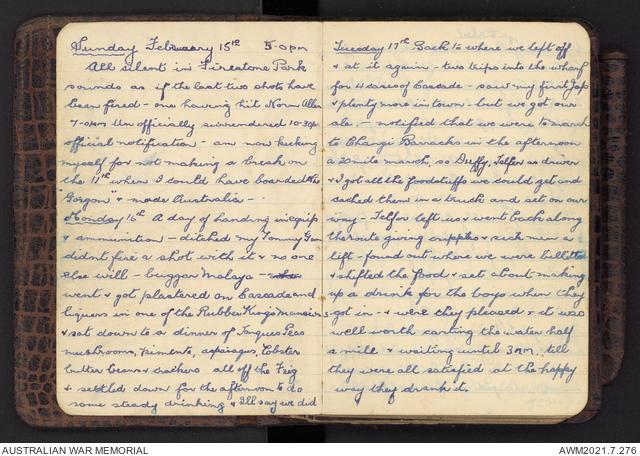Kicking myself for not making a break
It’s 10:30pm on Sunday 15 February 1942 at Firestone Park in Singapore; Private Bernard McCabe and his comrades in the 2/6 Field Park Company have just received official notification of surrender to the Japanese. Private McCabe is kicking himself “for not making a break on the 11th when I could have boarded the ‘Gorgon’ and made Australia.”
This is the first entry written by Private Bernard Henry McCabe in a diary that details his experiences as a prisoner of war at Changi camps between February 1942 and September 1945.
Born on 11 November 1903, Private Bernard Henry McCabe enlisted in the Second Australian Imperial Force at Claremont, Western Australia on 13 August 1940. He embarked from Fremantle on the troopship Zealandia in late May 1941 and arrived at Singapore on 9 June.
After landing in Singapore, the 2/6th Field Park Company, part of the 8th Division, moved to Malaysia and spent its days building camps, salvaging timber, and transporting goods and ammunition between field stores. The unit war diary for February 1942 describes “bombing and shelling in the vicinity”, before the company was “ordered to move towards Singapore” on 11 February, with the order to cease fire received on 15 February 1942.
Private McCabe’s diary entry for 16 February 1942, the day after surrender, details “a day of handing in equip[ment] and ammunition … and settled down for the afternoon to do some steady drinking”. The following day, McCabe was “notified that we were to march to Changi Barracks in the afternoon a 20 mile march.”
Entries throughout February and March 1942 provide insight into how Private McCabe established routines as a prisoner of war. He kept a record of his meals – four meals per day to begin with, but quickly reduced to three – and the changing price of tobacco. He also kept notes on football, baseball and cricket matches between internees, concerts performed by the prisoners, the marches, parades and inspections by Japanese officers, comrades who became ill, and prisoners who were executed trying to escape.
Throughout his time as a prisoner Private McCabe was admitted to hospital on numerous occasions. He suffered a broken toe (earned while playing baseball), ulcers on his feet and legs, malaria, dengue fever, diarrhoea, and beri-beri.
Private McCabe also reminisced on anniversaries, special occasions and birthdays of loved ones. On 29 May 1942 he marked “12 months by day since we boarded the Zealandia – I wish I was going back on her”. On 15 February 1944, he wrote, “2 years today since we tossed it in – how much longer”. By Christmas Day 1944, his second Christmas as a prisoner, he “hope[d] it is the last”.
8th Australian Division Prisoners of War at Changi Gaol. Photographer: Norman Stuckey, 117020.
After 1944, Private McCabe’s diary entries became less frequent. After making daily entries for almost three years, he began to group weeks together, perhaps as an indication of the repetitive nature of life in camp, or perhaps an indication of his poor physical and mental health. He recorded that “time [was] beginning to drag in here” and he was “feeling out of sorts”.
The final entry in Private McCabe’s diary in March 1945 notes that the Red Cross had sent another ship with food, medicine and clothing. Although this is the last personal account from Private McCabe, his service records provide further insight into his story. On 5 September 1945 he was recovered from the Japanese at Changi Camp. He embarked on the troopship Arawa on 19 September 1945, arriving in Sydney on 6 October 1945. He was discharged on 21 February 1946.
Changi, Singapore, ex-prisoners of war on their way back to Australia. 116450.
WX7858 Private B H McCabe is listed on the Memorial’s Second World War POWs and Missing Persons roll, which provides an overview of Australian Military Forces prisoners of war and missing personnel from operations in the Far East and South West Pacific Islands.
Private McCabe died on 27 March 1950. Through the donation of his diary to the Memorial, his story and his contribution to Australia lives on.
His diary has been digitised and is available to view here.


